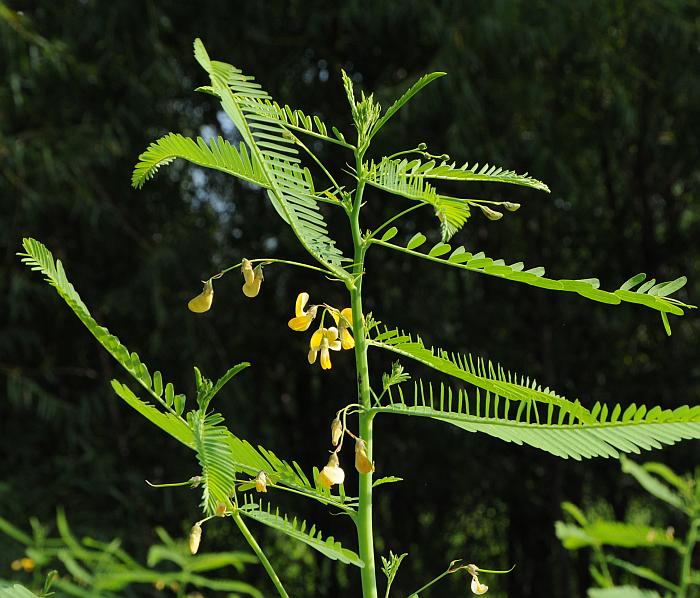Sesbania herbacea (Mill.) McVaugh
Coffee-Weed

Native
CC = 3
CW = -3
MOC = 15
© SRTurner
Sesbania herbacea (Mill.) McVaughCoffee-Weed | |
 |
Native CC = 3 CW = -3 MOC = 15 |
© SRTurner |
|
Family - Fabaceae/Faboideae Habit - Taprooted annual forb.
Stems - Erect, to 2 m, the base often somewhat swollen and spongy, glabrous, glaucous.
Leaves - Alternate, pinnately compound, short-petiolate. Blades 8-30 cm long, with 30-70 leaflets. Leaflets 10-25 mm long, 2-6 mm wide, narrowly oblong to occasionally linear, entire, the surfaces glabrous.
Inflorescence - Loose axillary clusters 2-6 cm long with 2-7 flowers, the flower stalks 5-9 mm long.
Flowers - Calyx tubes 3-4 mm long, with short triangular lobes, bell shaped, glabrous, the lobes 1-2 mm long. Corollas papilionaceous, 11-15 mm long, glabrous, yellow. Stamens 10, with 9 filaments fused nearly to the tip.
Fruits - Legumes, 10-20 cm long, 3-4 mm wide, quadrangular in cross section, with 20-40 seeds, these 3-4 mm long, oblong-ellipsoid.
Flowering - July - October. Habitat - Bottomland forests, streambanks, oxbows, sloughs, crop fields, railroads, roadsides, open disturbed areas. Origin - Native to North America. Other information - In Missouri, this weedy yet attractive species has been found in three disjunct regions: in the Bootheel, near the far southwestern corner of the state, and mid-state along the major rivers. Missouri lies along the extreme northern extent of the plant's natural range, which occupies much of the southern portion of the country. The plant is readily identified by its tall stature, glabrous stems, large compound leaves, big yellow flowers, and long, drooping fruits. The leaves grow perpendicular to the stem giving the plant a distinctive appearance. Plants can grow to 3m tall or more. There is some resemblance to S. vesicaria, but that species is quite rare in Missouri and has smaller flowers and much different fruits. Photographs taken off Hwy 29, Macon County, AL., 10-9-04 (DETenaglia); also Holly Ridge Conservation Area, Stoddard County, MO, 10-05-2011, Otter Slough Conservation Area, Stoddard County, MO, 8-19-2013, 9-11-2019, and 8-07-2022, and Dresser Island Conservation Area, St. Charles County, MO, 7-28-2020 (SRTurner). |